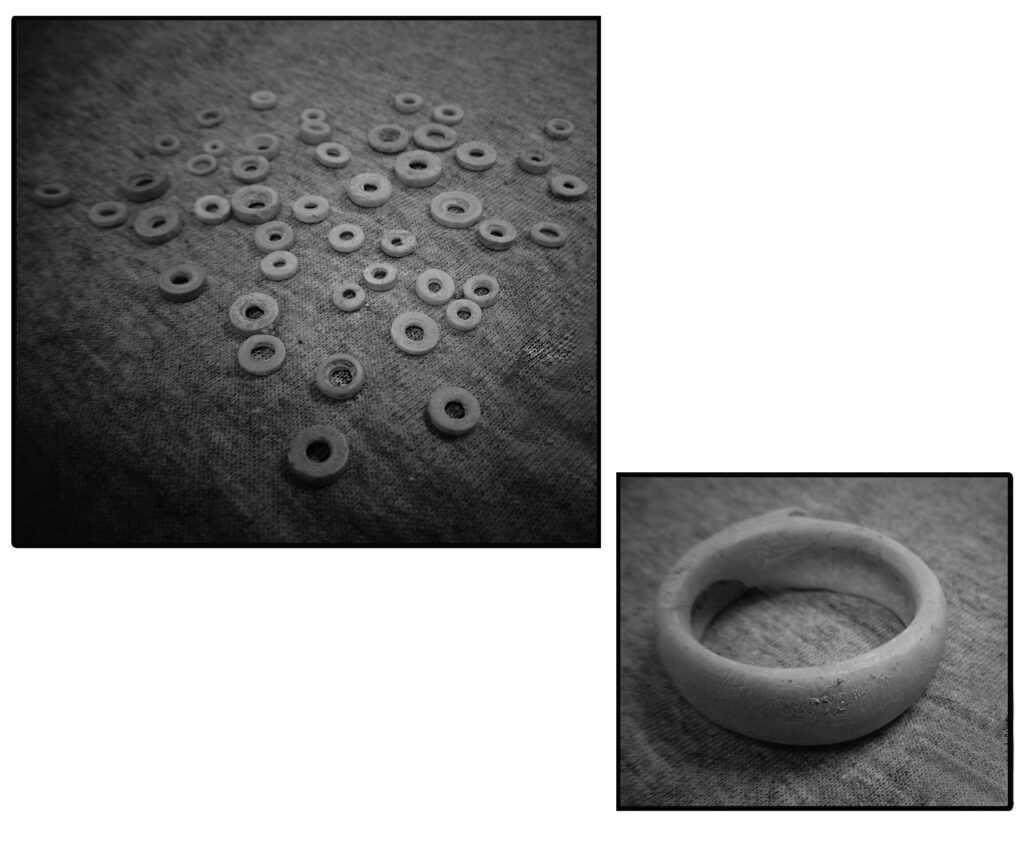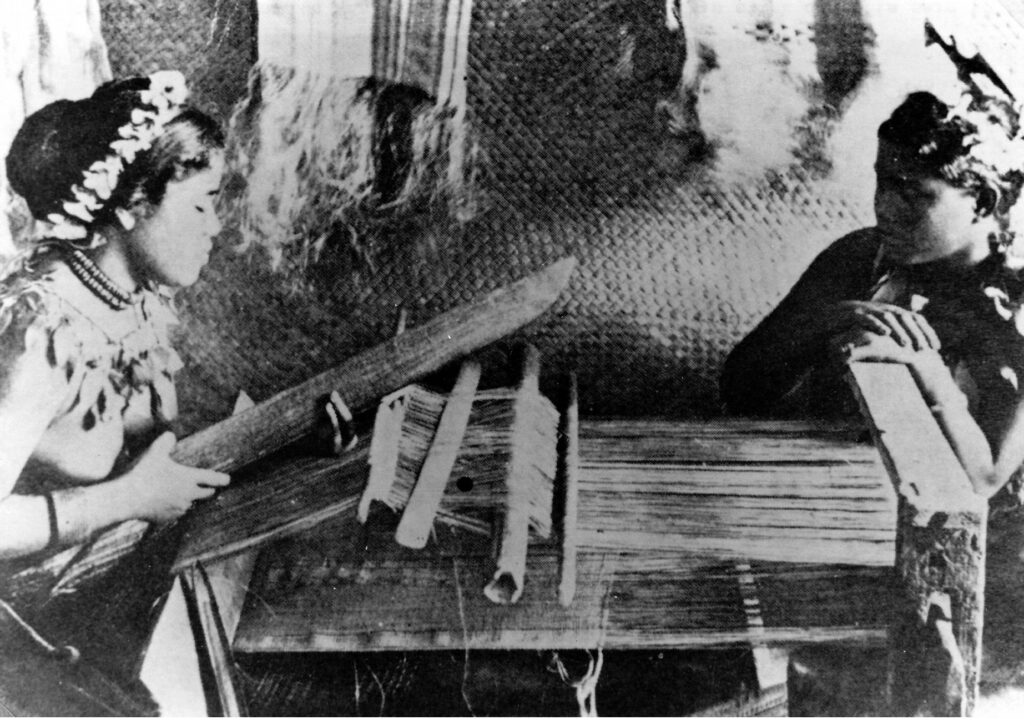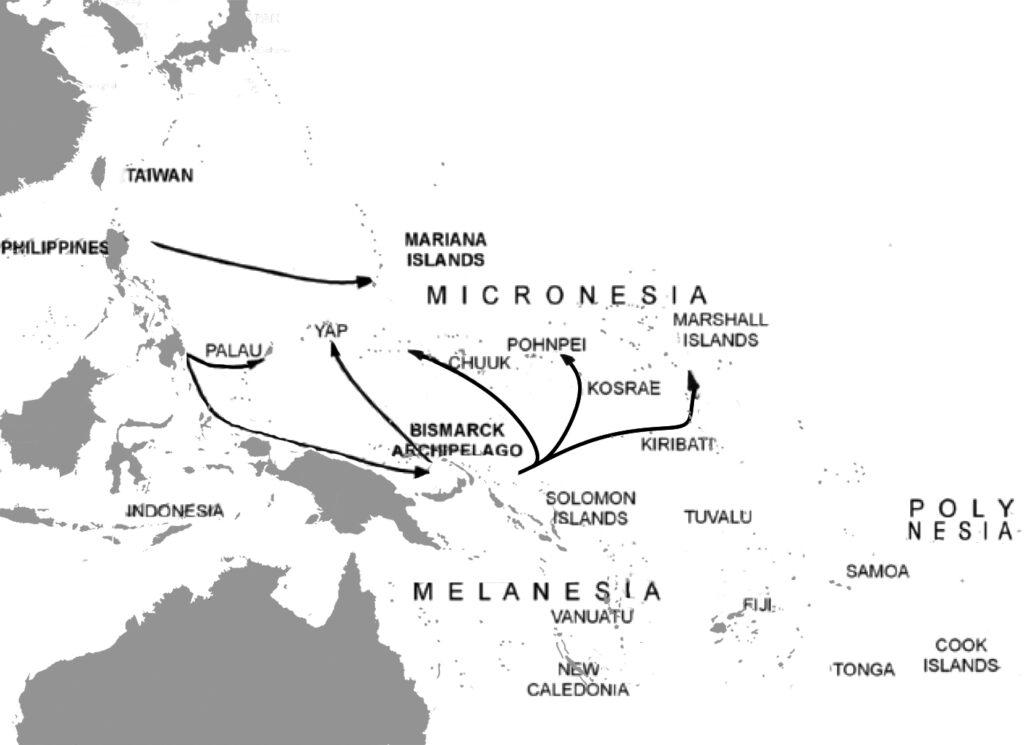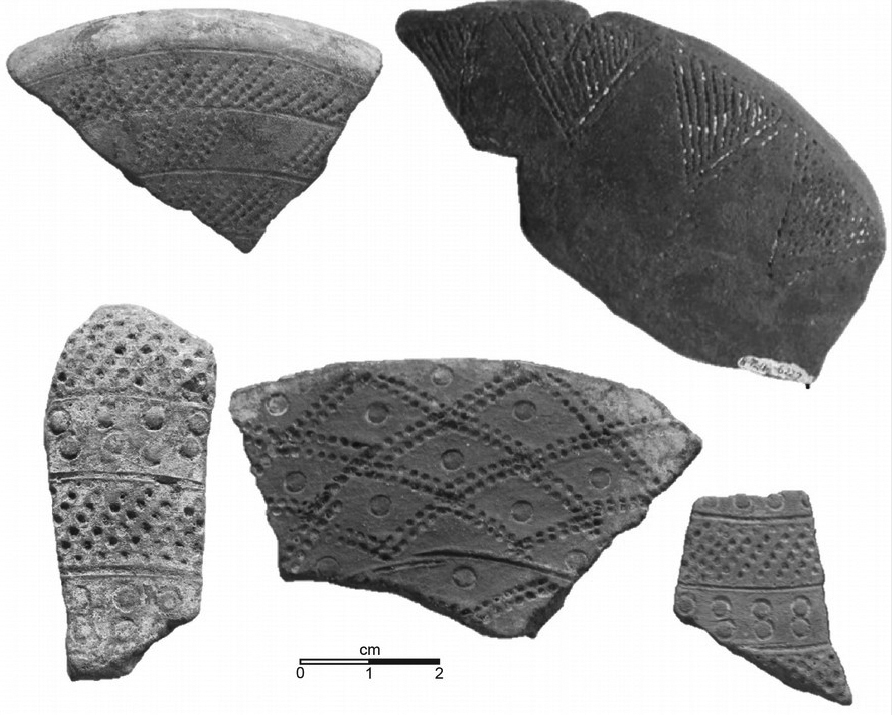2) Where the Original Settlers Come From
(1400 BC – 200 BC)
Who were the first people to settle these islands? Where did they come from?
The early settlers in Micronesia left us clues as to who they were and how they lived. They even offered hints of where they had come from. The remains that archaeologists have found in ancient burial sites and in the garbage pits of these people (midden sites, they are called) reveal most of what we know about them. Since these settlers left no written records of their voyages or discoveries, those who wish to learn about them must poke around in the earth to discover what they may have left buried beneath the ground. So, pits were dug on most of the major high islands and even on some of the outer islands like Fais and Lamotrek.
Cultural remains
From the remains in these pits we find that the early settlers brought simple pottery. But it seems their pottery-making didn’t last very long in their new home, probably because the clay wasn’t very good for making pots. Only in Yap did the tradition of pottery-making remain… right up to the present day.
They brought tools that they had learned to make from stone and shell long before they sailed to Micronesia. Their toolbox contained adzes for chopping and carving, scrapers and peeling knives, and shell fishhooks. But they also made carved ornaments for both men and women– adornments that they could wear proudly during their life and be buried with when they died.

These settlers also carried plantings for some of the food they needed to help survive on the islands they settled. They brought taro and yams as well as breadfruit. In addition, they also introduced dogs and perhaps pigs, animals that they could raise to feed themselves.
One of the more unusual imports was the loom employed for weaving fiber–not just plaiting strands of leaves to make a basket or a sleeping mat, but actual weaving of thread into cloth. The Caroline Islands were one of the few areas in the Pacific where people knew how to make thread and weave it on a loom. Pottery may have been lost, but weaving was kept, as we can see from the skirts and cloaks and loincloths made even to the present in some of the islands.

These early settlers also brought their language. That is something that can be a telltale sign of where they came from and what their pathway through Micronesia might have been. Many of the words in the languages of Pohnpei and Chuuk, along with the coral atolls ranging to Yap, are closely related. For that matter, the languages of Kosrae and the Marshalls also have many striking similarities. You can see this yourself if you compare such basic words as father, tooth, night, shark in these languages. The close similarity is no accident; it is evidence that the different islands were settled by speakers of one common language. It also suggests that the islands might have been settled roughly around the same time.
When and where
The evidence that has been gathered suggests the first settlers arrived a little over two thousand years ago, perhaps just a couple hundred years before the time of Christ. We’re not sure what island was settled first, but this group of sea-voyagers and those other groups that followed moved quickly from island to island until all the main islands were populated.
Where did these first settlers come from? Their toolkit, their sailing skills and their language all point to somewhere in northern Melanesia. The precise location is not clear, but it was probably the Bismarck Archipelago, perhaps the Admiralty Islands or New Britain.
Certainly the ancestors had lived in Melanesia for a long time, probably 1,000 years, before setting out for island Micronesia. It’s possible that they sailed off directly to the northeast where they found the Caroline Islands, but that’s a voyage of well over a thousand miles with nothing but sea in between. Most scholars think the settlers may have made a few stops along the way. They think that it might make more sense to imagine them following a string of islands in Melanesia before heading off to the north. Perhaps the voyagers sailed to Santa Cruz Islands or even Vanuatu before they veered upwards to follow the island chains running north-south into the Marshalls and eastern Carolines.
But that doesn’t account for all of Micronesia. What we’ve said above applies to what scholars call “Nuclear Micronesia”–everything between the outer islands of Yap and the Marshall Islands. Yap and Palau are the two islands to the far west that stand outside this area. The story of their settlement is different from the other islands, and it’s even more murky.

What do we know about the first settlement of Palau and Yap, then? Their languages are distant relatives of the others spoken in Micronesia, but not nearly as closely related as the rest of the languages are to one another. This makes it harder to figure out where they came from.
The first Yapese might have originally come from the Admiralty Islands, perhaps even around the same time the other settlers in the area arrived. But they might have taken a more direct route to their new home and brought with them stronger traces of their Melanesian home.
Palau’s settlement could date back much earlier, perhaps as far as a thousand years before the other islands of Micronesia were settled. We know that the Palauan language is far more ancient than the other Micronesian tongues; it is more closely related to Filipino but through the filter of Indonesia. There are still many unanswered questions about the settlement of both islands.
Way of life of the ancestors
These distant ancestors who lived in Melanesia for over a thousand years were a people who were comfortable on the deep sea. They resided in villages situated close to the shore, their houses usually perched on long poles, where they could easily gather fish and other marine resources. But they also planted root crops, mostly yams and taro, to help them survive on the land. Their food sources also included banana, breadfruit, pandanus, and sugar cane, and they planted bamboo and ginger for other uses.
As we’ve noted before, these people were pottery-makers. Those who do the digging in the old garbage dumps have found thousands of pieces of the pottery they made. We who have never been engaged in the digging sometimes wonder why all the fuss about pottery. But we must remember that the pots they made were not just supposed to serve as containers (for food or medicine or whatever), but to serve as a distinctive trademark for the people who made them. That’s why the design features on the pottery were so important. The design served as the insignia of the tribal people who used it, their calling card when they had dealings with other such groups.

These ancestors might have lived in Melanesia for more than a thousand years, but they were a sea-people at heart. They could make a home on an island group, growing their own crops and managing their own community, but they were also explorers who had the sailing craft and the navigational skills to set out in search of new lands.
Why leave home?
Even so, there are questions that must be asked. Why sail off into the wind on the open ocean? Wouldn’t it have been much easier to stay where they were instead of facing the risks of a long sea voyage?
It’s possible that resources might have been getting scarce and land more difficult to acquire as the population expanded. Then too, the push might have come from quarrels within the village or even within the family. Perhaps a younger brother who was chafing under the authority of his old brother wanted more breathing room and an estate of his own, even if he had to look for it on a distant island hundreds of miles away. But there’s still another motive–the sense of adventure–that lies deeply embedded in the genes of Pacific Island peoples. Why stay home when you can be exploring the fascinating world beyond? Their descendants a few thousand years later might have expressed this sense of adventure differently–by signing up on a foreign whaleship or enlisting as a plantation worker abroad in the 19th Century, or perhaps joining the US military today.
So off they went, sailing mostly into the northeasterly wind. If they didn’t find anything suitable, at least they could make it back home much more quickly with the wind at their back.
This is the introduction of a five-part series of posts on Micronesian Origins. The full list of posts are available below. You may also browse or download the PDF below.
- Introduction – Micronesians: Where Did They Come From?
- Ch 1) Back to the First Settlement of Our Islands (2,000 years ago)
- Ch 2) Where the Original Settlers Come From (1400 BC – 200 BC)
- Ch 3) The Beginning of the Seafarers (2500 BC-1400 BC)
- Ch 4) Through China to Taiwan (5000 BC-2500 BC)
- Ch 5) Out of Africa (50,000 BC)

